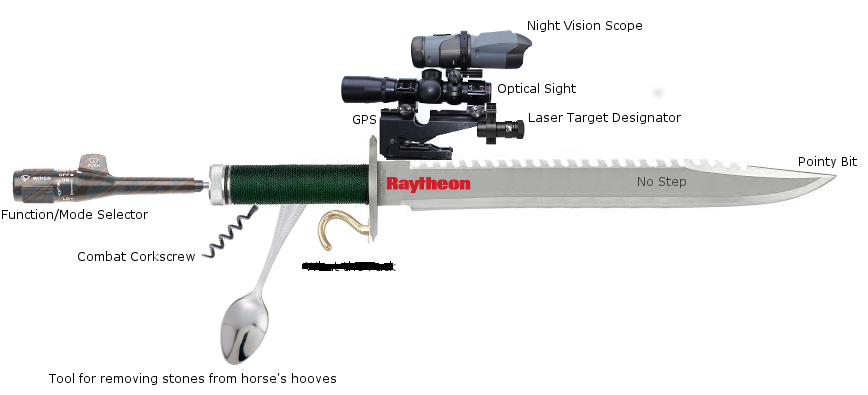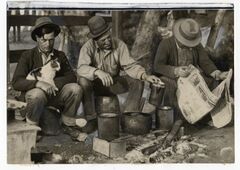American Army Knife
“It slices! It dices! Snaffles caps from jars, and it really, really works!”
Introduction[edit]
The Joint Advanced Attack Blade (JAAB), also known as the American Army Knife, is a hand-held weapon system intended for use in close-contact combat situations. It is currently fielded by the United States Army and Marines and Navy Seals. Initially developed by General Dynamics, the current Block-3 versions are manufactured by the Raytheon Corporation.
It is a multi-role weapon that can be employed in both defensive and attack modes, and typically finds use in situations where there is likelihood of close proximity encounters with hostile troops. It can be operated day or night under all weather conditions. The Navy version can be submerged in water for extended periods.
The JAAB has been widely recognized as an evolutionary weapon by military weapons experts and praised for its silent operation (beginning with the Block 3 upgrade), stealth capability, multiple implements and variety of effects and selectable mission profiles. Bertrum "Steel" Rayle of GUTS magazine proclaimed it as "the pinnacle of modern handheld weapon technology, no longer a 'weapon of last resort' but one which the modern warfighter can use to engage the enemy both proactively and preemptively ... and nothing carves up a turkey like this baby!."
Roosevelt's 'Knife Gap' speech[edit]
In 1901, shortly after taking office, speaking before the assembled members of the War Department, President Theodore Roosevelt related tales from his experiences as a Rough Rider in the Cuban War. One story in particular was poignant in its telling of his company's difficulty opening tins of food and dividing up a large block of cheese when no one was in possession of a knife and had to resort to using their bayonets, resulting in several injuries.
Roosevelt lamented the fact that of all the members in his regiment, none had been issued a standard knife that could be used for personal defense and utility purposes. "Bravely we fought with guns and swords, but in the end, when it is man to man you need something with a sharp edge and pointy too. Walking softly and carrying a big stick does no good when your enemy is charging you like a crazy monkey, screaming like a banshee and swinging a hatchet."
Having recently learned of the Soldier Knife developed by the Swiss in 1884, (later to be recognized as the Swiss Army Knife) he expressed his dismay that American troops were not being similarly equipped, admonishing the members and reminding them that it was their duty to properly outfit troops at all levels. "We cannot ask men to sacrifice their lives for their country, yet expect them to bring their own weapons to the fight." He warned of a growing 'knife gap' between the US and other nations. "Mark my words", he said, "trouble is brewing abroad and sooner or later we will find ourselves drawn into a conflict with foreign nations like Spain or Norway, so we cannot allow ourselves to become complacent and fail to prepare for the inevitable. Why, even the Swiss issue a knife for their troops! How can we expect our men to defend themselves when they can even cut the cheese properly?"
Initial Development[edit]
The ACME Sachel Company in Nelson's Mishap New Jersey was awarded a contract in the fall of 1903 to develop and deliver an early prototype for evaluation by the U.S. Army. Owner Wilbur Flurn, a long time brother of a close friend to Roosevelt was able to submit a large amount of cash in their bid, along with a drawing of a menacing looking knife. "Now that's what I'm talkin' 'bout!" was Roosevelt's enthusiastic response, "this is just the kind of thing I'd expect from a bunch of guineas in Jersey!"
Roosevelt would keep the drawing in his desk, and take it out to show to members of his cabinet when they contradicted him. "You see this?" he'd ask, "pretty soon I'll have one of these ... then we'll see what's what." Senator Nelson Aldrich was particularly impressed by Roosevelt's words and that played a part in the success of Roosevelt's gaining passage of the Hepburn Act.
The first prototypes were delivered to the U.S. Army's Cutlery Testing Division for testing in 1904. Reaction to the weapon's capabilities were generally positive. It received high marks for its ability to nick, jab, stab and poke; however, there were reports that found it lacking in its hack, skewer and carve performance. Roosevelt remarked that, "while it has a satisfying heft to it, it needs to make a more pronounced 'swishing' sound when swung about so the enemy knows it means business."
It was during the Operator Training phase that the real shortcomings of the prototype became obvious. Soldiers complained that the knife was awkward to carry and did not comfortably fit in their uniform pockets. They could keep it in their packs and retrieve it for various tasks as needed, but that made the response time when surprised by the enemy in mock battles unacceptably long.
Upon receiving these reports a Calvary Knife Program Office was established so that a set of formal requirements could be developed and presented to the contractor along with a formal test plan to ensure that the War Department could obtain the kind of knife that would best suit the needs of the soldier on the ground. It became clear during the requirements development that what was really needed was a knife that could fold back to its handle for safe storage and to make it easier to carry.
The requirements were forwarded to the Acme Sachel Company in a contract add on. After another year of development the second prototype was delivered.
Key Components[edit]
- 14" hardened chrome-vanadium high carbon steel blade with serrated spine
- SAASM GPS receiver
- Night Vision Scope
- 3-9 power adjustable optical sight
- Laser range finder/target designator
- Fork
- Spoon
- Tweezers
- Scissors
- Tooth pick
- Corkscrew
- Can opener
- Stapler
Effects[edit]
A multi-function control stick is provided to allow the user to select the mission profile, operating mode, feature configuration, and switch between semi and fully automatic operation.
The operating modes include:
- Brandish
- Poke
- Prick
- Stick
- Jab
- Cut
- Carve
- Chip
- Chop
- Hack
- Nick
- Slit
- Skewer
- Stab
- Shave
- Slice
- Slash
- Eviscerate
- Dismember
- Whittle
Stealth Capability[edit]
The unit is designed to present a very small radar cross-section which makes it virtually invisible to enemy radar installations.
Mission profiles[edit]
Several mission profiles are pre-programmed into the on-board guidance system which may be selected by the war fighter to enhance the attack capabilities, They include the following modes:
This profile is only available by executive order and requires an encrypted authorization code to be entered via a crypto fill device like the CYZ-10 or KYK-13 using a special adapter (P/N JU-1000042-423Q99J/14-0) connected to the USB port. This renders the device a de-facto weapon of mass destruction under UNSC 1540. The Commanding Officer must work with all units under his command to ensure no friendly forces are present within a 250KM radius. Troops executing this profile must be specially trained (certified) in its operation.
Operation[edit]
Deploying the knife requires the user to perform the 'three step' procedure: Acquire, Designate and Deploy.
The enemy is located by using either the optical sight in daylight or the night vision scope at night. The location (Latitude/Longitude or MGRS coordinates) of the enemy are entered using the multi-function control stick. The range and bearing to the enemy, relative to the user's current location as determined by the internal GPS receiver, will be displayed in the night vision scope eyepiece.
When the enemy is sighted, the laser target designator is switched on to place the laser spot on the enemy. This spot indicates where the blade will make contact.
Using the multi-function control stick, the user configures the operating mode. Depending on the selected mode, the blade is either extended or swept towards the enemy. The mode, coupled with the GPS receiver and laser range finder, is used to determine and indicate the proper amount of extension to ensure effective contact with the enemy.
In the semi-automatic mode, the user can re-designate the target and perform a second weapon engagement without needing to re-acquire the target.
In the fully automatic mode, the weapon can be deployed at will as the laser designator will automatically track the target. This is particularly effective in the stab, slash, turtle and dismember modes.
Specifications[edit]
- Power
- 5VDC (USB)
- Power consumption
- 5W (Max)
- Size
- Length 22.3"
- Width 4.4"
- Height 6.7"
- Weight 9.2 lbs.
- Shock/Vibration
- MIL-STD-810F
- Immersion
- 6 meters
Accessories included[edit]
- Sheath
- Belt
- Lightning arrestor
- USB Charging cable
- Vehicle Charger
- USB Fill cable
- Accordion
- Radar absorbent gloves
- Ear plugs
- Sharpening kit
- Tripod
- Chart illustrating various cuts of beef and pork
Survival kit[edit]
(Included in handle)
- Whistle
- Fish line and hook
- Condoms
- Viagra capsule
- 1 oz gold dust in vial
- Slim Jim mini
- Water purification pills
- Umbrella
- Fake moustache
- Pen knife
Cost[edit]
$17,435.23 (USD)
Conclusion[edit]
The American Army Knife is the most effecient weapon any G.I. could hope to carry into battle. Stocks are limited due to the high failure rate of people being issued with them.




